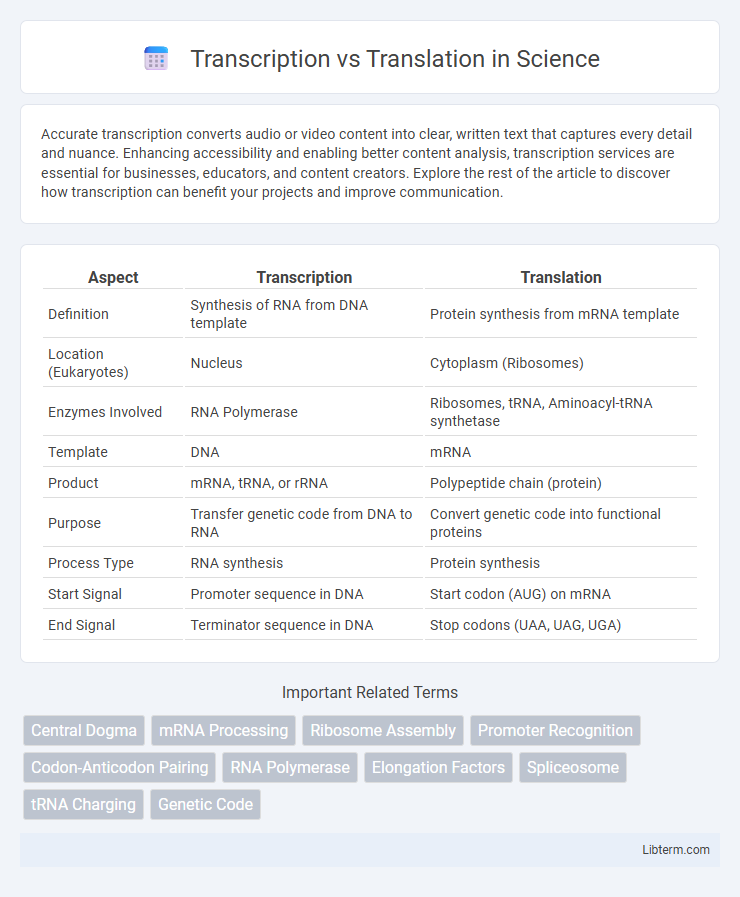Accurate transcription converts audio or video content into clear, written text that captures every detail and nuance. Enhancing accessibility and enabling better content analysis, transcription services are essential for businesses, educators, and content creators. Explore the rest of the article to discover how transcription can benefit your projects and improve communication.
Table of Comparison
| Aspect | Transcription | Translation |
|---|---|---|
| Definition | Synthesis of RNA from DNA template | Protein synthesis from mRNA template |
| Location (Eukaryotes) | Nucleus | Cytoplasm (Ribosomes) |
| Enzymes Involved | RNA Polymerase | Ribosomes, tRNA, Aminoacyl-tRNA synthetase |
| Template | DNA | mRNA |
| Product | mRNA, tRNA, or rRNA | Polypeptide chain (protein) |
| Purpose | Transfer genetic code from DNA to RNA | Convert genetic code into functional proteins |
| Process Type | RNA synthesis | Protein synthesis |
| Start Signal | Promoter sequence in DNA | Start codon (AUG) on mRNA |
| End Signal | Terminator sequence in DNA | Stop codons (UAA, UAG, UGA) |
Introduction to Transcription and Translation
Transcription is the process where the DNA sequence is copied into messenger RNA (mRNA), enabling genetic information to be transferred from the nucleus to the cytoplasm. Translation follows transcription by decoding the mRNA sequence into a specific polypeptide or protein at the ribosome, synthesizing functional proteins based on genetic instructions. Both transcription and translation are crucial steps in gene expression, with transcription involving RNA polymerase enzyme activity and translation relying on ribosomal machinery and transfer RNA (tRNA).
Defining Transcription
Transcription is the process of converting DNA sequences into complementary RNA strands, enabling gene expression by producing messenger RNA (mRNA) that carries genetic information to the ribosome. This critical step occurs within the cell nucleus in eukaryotes and involves enzymes such as RNA polymerase binding to the DNA template strand. Transcription ensures accurate transfer of genetic code, setting the foundation for subsequent protein synthesis through translation.
Understanding Translation
Translation is the cellular process that converts messenger RNA (mRNA) sequences into functional proteins by decoding nucleotide triplets called codons. Ribosomes facilitate this process, matching each codon with the corresponding amino acid delivered by transfer RNA (tRNA) to synthesize polypeptide chains. Understanding translation is critical for studying gene expression, protein synthesis, and molecular biology applications such as genetic engineering and disease research.
Key Differences Between Transcription and Translation
Transcription converts DNA or RNA sequences into complementary RNA strands, while translation decodes mRNA sequences into protein chains. Transcription occurs in the nucleus of eukaryotic cells, whereas translation takes place in the cytoplasm at ribosomes. Key enzymes differ, with RNA polymerase facilitating transcription and ribosomes driving translation through codon recognition and peptide bond formation.
Similarities Between Transcription and Translation
Transcription and translation are fundamental processes in gene expression involving the conversion of genetic information from DNA to functional proteins. Both processes utilize RNA as a key molecule: transcription synthesizes messenger RNA (mRNA) from DNA, while translation decodes mRNA to assemble amino acids into polypeptides. Each process relies on ribonucleic acids, specific enzymes like RNA polymerase in transcription and ribosomes in translation, and follows a sequence-specific mechanism dictated by nucleotide sequences.
The Biological Importance of Each Process
Transcription is essential for converting DNA sequences into messenger RNA, enabling the genetic code to be expressed as proteins, which regulate cellular functions and maintain life. Translation interprets the mRNA sequence to assemble amino acids into proteins, crucial for enzyme activity, structural support, and cell signaling. Both processes are fundamental for gene expression, cellular growth, and response to environmental changes.
Steps Involved in Transcription
Transcription begins with the binding of RNA polymerase to the DNA promoter region, initiating the unwinding of the double helix to expose the template strand. RNA polymerase then synthesizes a complementary RNA strand by adding ribonucleotides in the 5' to 3' direction based on the DNA template. The process concludes with termination signals that prompt RNA polymerase to release the newly formed mRNA and dissociate from the DNA.
Steps Involved in Translation
Translation involves three key steps: initiation, elongation, and termination. During initiation, the ribosome assembles around the target mRNA, and the first tRNA binds to the start codon. Elongation follows as amino acids are sequentially added to the growing polypeptide chain until a stop codon triggers termination, releasing the completed protein.
Common Errors and Challenges in Each Process
Transcription errors often include misinterpretation of homophones, incorrect spelling, and omission of words, which can lead to inaccurate written records. Translation challenges arise from cultural nuances, idiomatic expressions, and context-specific meanings that require deep linguistic and contextual understanding to maintain the original message's intent. Both processes demand meticulous attention to detail and subject matter expertise to avoid significant communication errors.
Applications in Biotechnology and Research
Transcription converts DNA sequences into messenger RNA, enabling gene expression analysis critical for identifying genetic disorders and developing targeted therapies. Translation synthesizes proteins from mRNA templates, facilitating protein production essential for drug development, enzyme engineering, and synthetic biology. Both processes are fundamental in biotechnology for recombinant protein manufacturing, gene editing, and studying cellular functions in research.
Transcription Infographic

 libterm.com
libterm.com